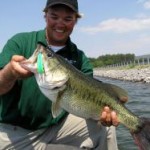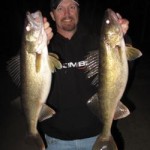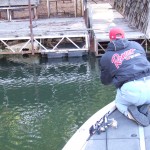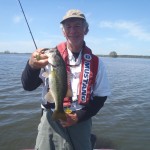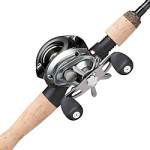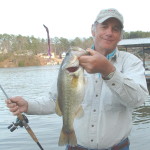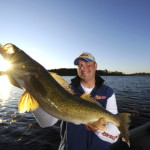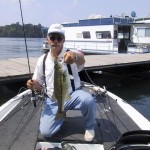
I saw this bass holding under a dock and caught it on a Trick
Best Bets for Georgia Spotted Bass
Tell a bass fisherman spotted bass are not native to Georgia and he will look at you like you are crazy. After all, every big lake in the state has spots in them, and in many of our lakes they outnumber largemouth by a wide margin.
Add that spots are bad for the largemouth population in most lakes and you really will get that “You are crazy” look, and will get many arguments. Unfortunately, the arguments are “fisherman” knowledge and are not based on biology or science. The misunderstanding about how spots affect a lake is one reason they are so widespread.
Spotted bass are native to the Mississippi River drainage, including the Tennessee River that has some tributaries that barely touch Georgia, but Georgia waters are not in their native range. Spots were stocked into every lake in Georgia, mostly by fishermen that liked to catch them. They do have some good qualities but also change the dynamics of a lake and affect the largemouth population in negative ways.
WRD Senior Fisheries Biologist Anthony Rabern is responsible for northeast Georgia lakes has some interesting information about spotted bass. For one thing, spots don’t really move from one lake to the next one downstream naturally. It is possible for them to get through a dam and move downstream, but unlikely. So the spots downstream of Lanier in West Point, Bartletts Ferry and others probably did not get there through natural means.
Spots are more aggressive than largemouth, one of their endearing qualities to fishermen. But that also means they out compete largemouth for food, so a few spots can turn into the predominate species in a lake fairly quickly. Spots are fun to catch and pull hard, but they don’t grow as fast as largemouth and don’t reach the same sizes as largemouth.
Lakes can support a certain biomass per acre of bass. Since spots don’t grow as fast or as big as largemouth but are more aggressive, that lowers the average size of the bass in the biomass. Spots compete with largemouth for the available food, and usually out compete the largemouth.
For a theoretical example, if a lake can support 100 pounds of bass per acre, it does not matter if it is 100 pounds of spots or 100 pounds of largemouth, or a mixture of the two. So with largemouth, you would expect to find a variety of smaller fish in the one pound range, a good many in the two to three pound range, and some above five pounds. But with spots you would tend to have 100 one-pound fish.
Spots also act differently. They roam the lake more and chase baitfish. Rabern says when they tag a largemouth bass and release it at Point “A” in the lake it will usually stay near that point the rest of its life. But a spot may be tagged and released up a river and show up near the dam a few days later, even in big lakes.
This roaming and following baitfish is the reason blueback herring really help the spotted bass population in a lake. Bluebacks cause a lot of problems when established in a lake, but under the right conditions they become the favorite food of spots and make them grow bigger and fatter. Lake Lanier is a good example of that interaction, but it does not happen on all lakes.
Two north Georgia lakes offer opposite extremes. At Lake Chatuge there are large numbers of spots but most are 10 inches long or less. Those ten inchers still fill the biomass and reduce the number of largemouth in the lake. Lake Burton has a lot of big spots, and the state record 8 pound, 2 ounce spot came from it. Two similar lakes with very different results from the introduction of spots.
Many lakes in Georgia have gone from no spots to two-thirds spots and one third largemouth in just a few years. Where fishermen used to catch a variety of sizes of largemouth they now catch a bunch of small spots. It is fun to catch a lot of bass, but you give up catching quality fish in most cases when spots take over.
Each club in the Georgia Bass Chapter Federation sends Creel Census reports to Dr. Carl Quertermus at University of West Georgia each year, reporting on each club’s tournament catches. One of the questions is the percentage of bass that are largemouth, and that data shows the trend when spots get into a lake.
Lanier has long had a good spot population but in 1994 27.49 percent of club tournament catches were largemouth. By 2010 that was down to only 10 percent. Allatoona is also known for having spots for many years. In 1994 26.71 percent of bass were largemouth, by 2010 it was 9.8 percent. The largest average bass at Allatoona in 1994 was 3.27 pounds, by 2010 it was down to 2.81 pounds. At Lanier the average size of the largest bass actually went up from 3.49 pounds in 1994 to 3.75 pounds in 2010.
West Point did not have a large population of spots in its early years but they are much more common now. In 1994 90.17 percent of bass in club tournaments were largemouth, but the 16 inch size limit on largemouth may have impacted that number of spots weighed in. By 2010 only 34.3 percent of the catch was largemouth and the average largest bass went from 4.56 pounds to 4.27 pounds.
The following lakes give you a good chance to catch spots, some of decent size, this spring.
Lake Lanier
Spots have been in Lanier almost since it was dammed. Back in the 1970s you could catch them but most were small. After bluebacks were introduced to the lake the spots grew in weight and now you can catch big spots there. Unfortunately, not all lakes respond to this combination like Lanier.
Three pound spots are common on Lanier and five pounders are weighed in at most tournaments. Seven pounders are caught every year and some fishermen say they have had on eight pound plus spots. You have a change of breaking the state record for spots on Lanier in May.
Spots are aggressive when on the bed, and in late April and early May some are still bedding since spots tend to bed later than largemouth. If you find one on the bed you are likely going to be able to get it to hit on just a few casts. So looking for bedding bass is a good tactic. Drop a small jig and pig or Texas rigged worm in the bed and the spot will eat it.
Herring spawn in May on open water cover like shallow gravel bars, and the “blowthrough” fishing for spots on the herring spawn is fantastic. Go out to just about any island or long point on the lower lake below Browns Bridge and throw a big topwater bait like a Zara Spook or Sammy at first light and you will catch some big spots.
A spinnerbait, soft or hard jerk bait or swimbait also works well in the same places. You are looking for a gravel bottom in six feet of water or less and should work your bait from very shallow out to 15 feet deep. Spots will come up from cover to smash the bait even after the early morning feed when they are roaming the gravel looking for herring.
After the sun gets up the spots will hold on deeper cover like brush piles and standing timber but will still come up to hit baits fished over them, especially if wind puts some chop on the water. You can also fish the cover with a jig head worm, drop shot rig or small jig and pig to catch them where they are holding. Look for cover in 25 to 30 feet of water, especially toward the end of the month, and work your bait through it.
Lake Burton
Lake Burton is another success story where blueback herring and spots have produced a good fishery. The Georgia Department of Natural Resources, Wildlife Resources Davison says it is a quality spotted bass fishery. An adequate food supply, mainly blueback herring, coupled with a spot population that tends to have fish that live longer, make big spots common.
The state record spot came from Burton and the WRD says it has the potential to produce a new world record spot, weighing more then the current 10 pound, 4 ounce fish. There are above average numbers of spots over 12 inches long and above average trophy fish, so if you want a wall hanger spot Burton would be a good choice.
The same patterns for the blueback spawn that work at Lanier will work at Burton. Another pattern that works well on Burton is to fish a Super Fluke and Texas rigged worms around boat docks and blowdowns in deep water. The lower lake is the best area to catch big spots.
West Point Lake
The population of spots at West Point has exploded in the past 15 years and there are some big spots in the lake. Bluebacks have been showing up there, too, but the population is not dense enough yet to really offer a good spawn fishery. Spots tend to rely on shad on West Point and the shad spawn is pretty much over by May each year, but you can still catch some on the places the shad spawned.
Fish a gravel point below the Highway 109 Bridge before the sun comes up and you should have good action. A Spook or Sammy work well, but since the spots tent to be smaller also throw a smaller bait, like a Pop-R, on those points. They can get the smaller bait in their mouths easier and you will hook more of the fish that hit.
After the sun gets up throw a Finesse worm on a jig head on those same gravel points, fishing from right on the bank out to 15 feet deep. Drag it along and then hop it every foot or so to draw their attention. A little chartreuse on the tail of the worm really attracts spots, so dip your favorite color in JJs Magic.
Fish the same bait or a small jig and pig on rocky points on the lower lake for spots, too. If the water is clear, browns and green pumpkin work well, but if it is stained try black and blue. Keep in contact with the bottom but hop the jig and pig along, imitating a fleeing crayfish. Spots love crayfish.
The bridge riprap and pilings on the railroad causeway, Highway 109 and in Wehadkee Creek are also good. A light one-eight ounce jig with a small chunk works well on the riprap and the light weight will keep you from getting hung in the rocks too much. Try a small crankbait on the rocks and around the pilings, too. Shad or crawfish colors work well.
Jackson Lake
The transition to spotted bass on Jackson Lake is the one with which I am most familiar. The two bass clubs I am in each fish it three times a year, and I have been fishing it since 1974. My first two eight pound bass came from there in club tournaments in the 1970s, and my best ever, a nine pound, seven ounce fish came in a club tournament there in 1992.
We have had some memorable catches. The day I caught my second eight pounder there were two other eight pounders weighing a little more weighed in. I netted a nine pound, two ounce bass for my partner in one tournament where there was another nine pounder, an eight and a seven the same day. We seldom fished Jackson without a seven pound plus fish being weighed in, but there has been only one weighing over seven pounds in the past 10 years.
In 1992 at a weigh-in someone said “That looks like a spot,” and it was, the first we ever weighed in. Now at least three fourths of the bass we catch are spots and we have had many tournaments where not a single largemouth was brought to the scales. In the Creel Census Report, in 1994 99.52 percent of bass were largemouth. The percent largemouth was in the upper 30s to low 40s the first nine years this century, but for some reason in 2010 largemoouth were 52.1 percent.
There are some big spots in Jackson and we usually have some over three pounds, with an occasional four pounder. The best bet this time of year it so throw a topwater popper around rocky points on the main lake early in the morning. If you can find a May Fly hatch it really makes it better.
After the sun gets up back off and throw a jig head worm on the rocky points. Use a five inch worm in green pumpkin and dip the tail in dye to make it more attractive to spots. Work it from right on the bank to 15 feet deep. Rocks are the key to catching spots on Jackson.
Lake Russell
Lake Russell is full of spots and some of them are big. Club fishermen transported spots from Lanier to Russell as soon as it was built and they have taken over. In 1994 99.83 percent of bass in club tournaments were largemouth. By 2010 that was down to just 42.3 percent largemouth.
The simplest pattern for finding spots on Russell is to run the poles marking the channels and fish around each one. The poles mark the ends of points in most cases and many have rocks around them. Fishermen have put out brush around most of them, too.
Fish a Spook over the points around the poles in the morning then fish them with a small jig and pig or jig head worm. Probe for the rocks and brush and jiggle your bait when you hit cover. Make it quiver in one place as long as you can. Doodling was invented for spots and it works wherever they live.
Also try the riprap. Shad spawn on it so a spinnerbait or topwater works well around the rocks on the many bridges in Russell. Soft jerkbaits like Flukes are good, too. Fish them as an angle to the rocks, keeping your boat in fairly close. Cast right on the bank and work the Fuke back to the boat parallel to the rocks.
These patterns and techniques will work on most any lake with spots, and that means most of our lakes. Give them a try. Rocks are always the key, and clear water is usually best for spotted bass, so stick with clear water lakes.
Spots are here to stay, no matter if they are good or bad for a lake. There is no size limit on spots on any lake except Lanier, so if you want some fish to eat take home a limit of small spots. They taste good and removing them won’t hurt the lake. In fact, it may help.
